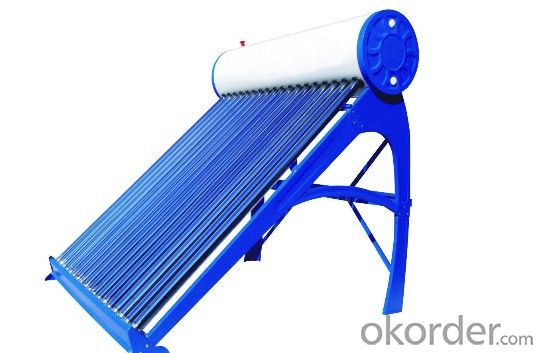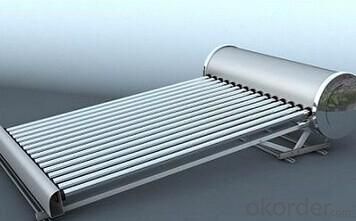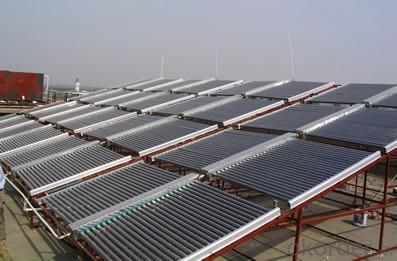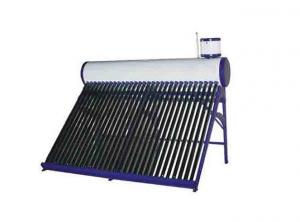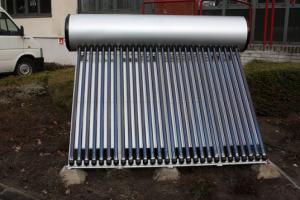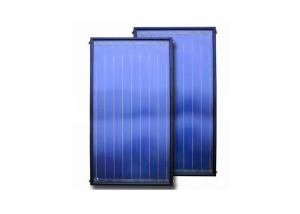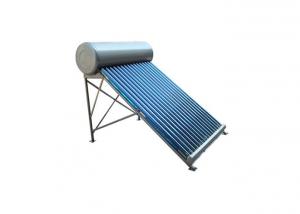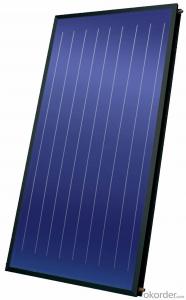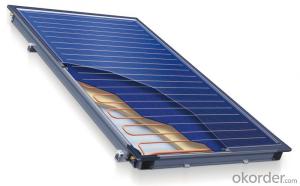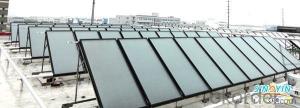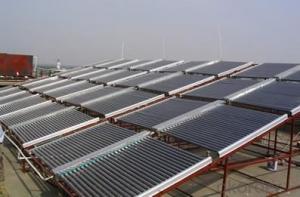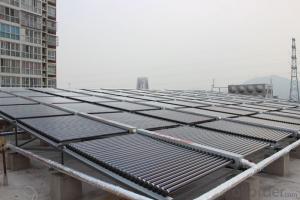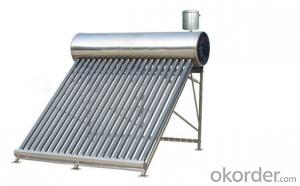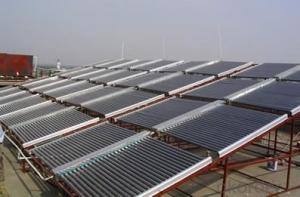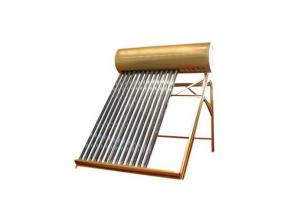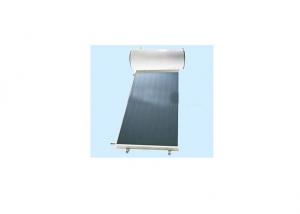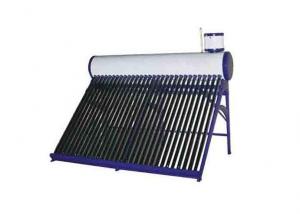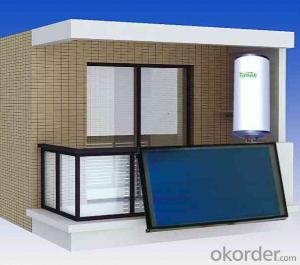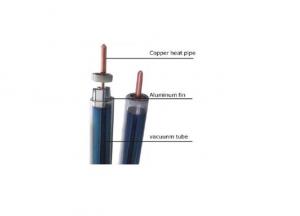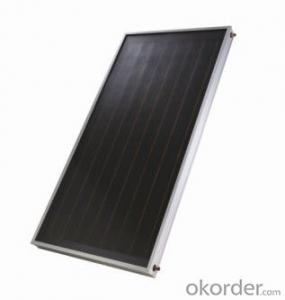Unglazed Solar Collectors Pressurized Heat Pipe Solar Water Heater System
- Loading Port:
- China main port
- Payment Terms:
- TT OR LC
- Min Order Qty:
- 1 set
- Supply Capability:
- 6000 set/month
OKorder Service Pledge
OKorder Financial Service
You Might Also Like
Introduction of Non-Pressure Solar Water Heater:
Non-pressure Solar Heater is one of the most economical solar water heating device with pretty high efficiency at the same time. It consists of hot water storage tank, solar vacuum tubes with mouth plug in storage tank, and bracket supporting tank and tubes.When cold water in evacuated tubes is heated with solar irradiation, as the specific gravities of hot water and cold water are different, hotter water goes upward to storage tank and colder water goes downward to glass tubes. through this continuous circulation, the cold water in storage tank will be gradually heated till sunset.
Specialty:
1. High thermal performance and working temperature: the heat exchanging rate even in winter can up above 55%.
2. Heat collecting efficiency is at least 20% above common solar systems.
3. Work in all day and all season: no matter any corner of the world, this system can work well even -40℃ to avoid the tube freezing problem.
4. Reliability: No water following through the tube, so water scale can not generate and tube cracks could be avoided, the system still can keep working even with some damaged tubes.
5. It can connect with water tap and work automatically with pressure0.6Mpa, bring enjoyable washing experience.
6. Safety: P/T valve would release pressure and temperature to protect tank..
Technical Specification:
1. Outer tank material: SUS304 stainless steel or powder coated color steel
2. Inner tank material: 1.2mm thick SUS304 food grade stainless steel ( Optional material SUS316L)
3. Vacuum tube material: borosilicate glass 3.3; AL-SS-CU absorb coating, with copper heat pipe inside
4. Frame material: 1.2mm thickness stainless steel
5. Insulation material: 55mm thickness polyurethane
6. Suitable for mains pressure water(up to 8 bar/116psi)
7. Easy plug-in installation
8. Install the T/P valve on the pressurized tank
9. Seal material: Stabilized High Temperature Silicon
Outer tank material: SUS304 stainless steel or powder coated color steel
Inner tank material: 1.2mm thick SUS304 food grade stainless steel ( Optional material SUS316L)
Vacuum tube material: borosilicate glass 3.3; AL-SS-CU absorb coating, with copper heat pipe inside
Frame material: 1.2mm thickness stainless steel
Insulation material: 55mm thickness polyurethane
Suitable for mains pressure water(up to 8 bar/116psi)
Easy plug-in installation
Install the T/P valve on the pressurized tank
Seal material: Stabilized High Temperature Silicon
19. Vacuum Tube | 20. Size (mm) | 21. Φ47*1500 / Φ58*1800 / Φ70*2100 | |||||
22. Tube (pcs) | 23. 10 / 12 / 15 / 18 / 20 / 22 / 24 / 30 / 36 / 42 | ||||||
24. Material | 25. Borosilicate 3.3 glass, magnetron spluttering selective coating | ||||||
26. Coating | 27. Single-target AL-N/AL or Three-target AL/N-Cu-SS | ||||||
28. Water Tank | 29. Capacity | 30. 80L ~ 500L for hot water storage tank | |||||
31. Inner tank | 32. Food-grade stainless steel SUS304-2B / SUS316 | ||||||
33. Insulation | 34. High-density polyurethane foam with 70~80 hour heat preservation | ||||||
35. Tank shell | 36. Food-grade stainless steel SUS304-2B | ||||||
37. Bracket | 38. Shaped strong aluminum alloy structure adaptable for flat or slope roof | ||||||
39. Accessories | 40. Anti-aging silicon seals, Dustproof seals, Air-vent cap, Stainless screws | ||||||
41. Auxiliary Devices | 42. Assistant tank, Intelligent controller, Electrical heater, Magnesium anodes | ||||||
43. Tilt Angle | 44. 25 ~ 50° | ||||||
45. Water Output | 46. 45 - 95°C | ||||||
47. Hail Resistance | 48. Φ25mm diameter | ||||||
49. Model Number | 50. Solar Vacuum Tube | 51. Tank 52. Liter | 53. System 54. Liter | 55. Container Loading Qty /sets | |||
56. Size /mm | 57. Qty /pcs | 58. 20GP | 59. 40GP | 60. 40HQ | |||
61. VNS-58SA12-100 | 62. Φ58*1800 | 63. 12 | 64. 100 | 65. 132 | 66. 58 | 67. 119 | 68. 140 |
69. VNS-58SA15-130 | 70. 15 | 71. 130 | 72. 170 | 73. 54 | 74. 108 | 75. 131 | |
76. VNS-58SA18-150 | 77. 18 | 78. 150 | 79. 198 | 80. 43 | 81. 86 | 82. 105 | |
83. VNS-58SA20-170 | 84. 20 | 85. 170 | 86. 223 | 87. 40 | 88. 80 | 89. 97 | |
VNS-58SA24-200 | 24 | 200 | 263 | 35 | 70 | 85 | |
VNS-58SA30-250 | 30 | 250 | 329 | 28 | 56 | 68 | |
VNS-58SA36-300 | 36 | 300 | 395 | 23 | 47 | 57 | |
Product Show
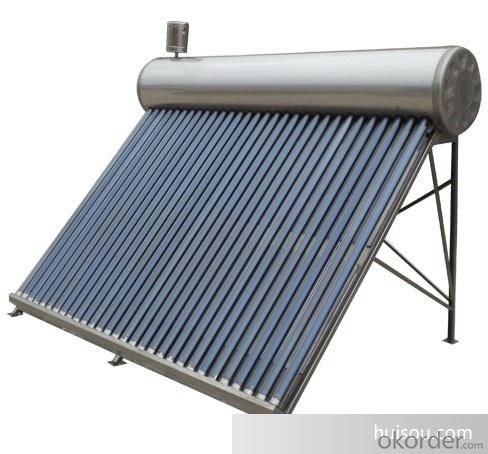
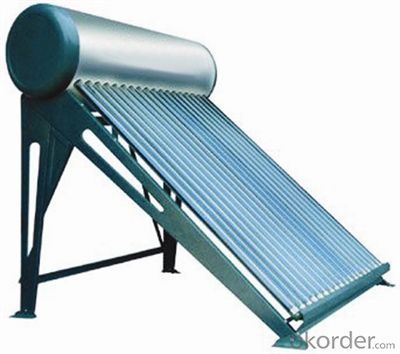
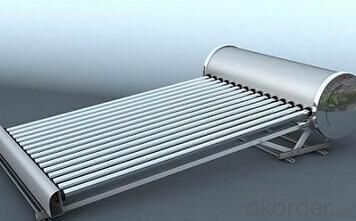
Our Services
1. OEM service
2. Warranty: 5 years
3. Considerable after sale service
Color steel Compact pressure Thermal solar heater
FAQ:
1. What’s the delivery time?
10 days after receiving deposit.
2. How long is the warranty?
5 years for whole system, 1 year for accessory
3. What’s your production capacity?
6000sets/month
4. What’s the MOQ?
1 set.
5. What’s your payment term?
Container: 30% T/T in advance for deposit, 70% T/T before shipment for fist order.
70% T/T after seeing copy of B/L from second order
Sample: 100% T/T in advance
Other choices: L/C at sight.
6. What certifications do you have?
CE, SOLAR KEYMARK, SRCC and etc.
- Q: Can solar collectors be used in areas with limited transportation infrastructure?
- Yes, solar collectors can be used in areas with limited transportation infrastructure. Solar collectors are typically installed on rooftops or open spaces, and once installed, they require minimal maintenance and do not rely on transportation infrastructure for their operation. This makes solar collectors a viable option for generating electricity in remote areas or regions with limited transportation access. Additionally, solar power can be stored in batteries, allowing for a continuous energy supply even in areas with limited transportation infrastructure.
- Q: Can solar collectors be used for heating schools?
- Yes, solar collectors can be used for heating schools. Solar thermal systems can capture the sun's rays and convert them into heat energy, which can be used to heat water or air for heating purposes in schools. This renewable energy source is not only environmentally friendly but also cost-effective in the long run, making it a suitable option for heating schools.
- Q: Can solar collectors be used in aquaculture?
- Yes, solar collectors can be used in aquaculture. Solar collectors can provide the necessary energy to power various equipment used in aquaculture systems, such as pumps, aerators, and water heaters. This renewable energy source can help reduce operational costs and environmental impacts associated with traditional energy sources. Additionally, solar collectors can also be used to heat water for maintaining optimal temperature conditions in aquaculture tanks or ponds, enhancing the growth and health of aquatic organisms.
- Q: Can solar collectors be used in educational institutions?
- Yes, solar collectors can definitely be used in educational institutions. They can be installed on rooftops or open spaces to harness solar energy and convert it into electricity or heat. This allows educational institutions to reduce their reliance on traditional energy sources, lower their carbon footprint, and educate students about renewable energy and sustainability. Additionally, solar collectors can serve as a practical example for students to understand the benefits and applications of solar technology.
- Q: Can solar collectors be used in wave energy converters?
- Solar collectors cannot be utilized directly in wave energy converters. The purpose of solar collectors is to seize sunlight and transform it into thermal or electrical energy. Conversely, wave energy converters are exclusively engineered to exploit the kinetic energy of ocean waves. The mechanisms and technologies employed in these two energy conversion systems differ significantly, rendering them incompatible with one another. Solar collectors are better suited for solar power generation, whereas wave energy converters are specifically designed for wave power generation, capitalizing on the uninterrupted motion of the ocean to generate electricity.
- Q: What is the size of a typical solar collector?
- The size of a typical solar collector can vary depending on the specific application and design. However, a common size for a residential solar collector is around 2 meters by 1.2 meters, or approximately 6.5 feet by 4 feet.
- Q: Are there any financial incentives for installing solar collectors?
- Yes, there are several financial incentives available for installing solar collectors. These incentives include federal tax credits, state and local rebates, and net metering programs. Additionally, installing solar collectors can significantly reduce electricity bills over time, providing long-term financial savings.
- Q: Can solar collectors be used for heating mines?
- Yes, solar collectors can be used for heating mines. Solar thermal systems can capture and convert sunlight into heat energy, which can then be used for various purposes, including heating mine facilities. This can help reduce the reliance on fossil fuels and decrease the environmental impact of mining operations. However, the feasibility and effectiveness of using solar collectors for heating mines would depend on factors such as the size of the mine, available sunlight, and specific heating requirements.
- Q: Can solar collectors be used for heating data centers and server rooms?
- Yes, solar collectors can be used for heating data centers and server rooms. Solar thermal systems can be designed to collect and convert solar energy into heat, which can then be used to provide heating in these facilities. This can help reduce the reliance on traditional heating systems and decrease the overall energy consumption and carbon footprint of the data centers and server rooms.
- Q: Can solar collectors be used for heating agricultural processing facilities?
- Yes, solar collectors can be effectively used for heating agricultural processing facilities. Solar thermal technology can be employed to capture and convert solar energy into heat, which can then be utilized for various heating purposes in agricultural processing facilities such as drying crops, heating water for cleaning and sterilization, or providing space heating. This renewable energy solution can help reduce reliance on fossil fuels, decrease greenhouse gas emissions, and provide a cost-effective and sustainable heating solution for agricultural processing operations.
Send your message to us
Unglazed Solar Collectors Pressurized Heat Pipe Solar Water Heater System
- Loading Port:
- China main port
- Payment Terms:
- TT OR LC
- Min Order Qty:
- 1 set
- Supply Capability:
- 6000 set/month
OKorder Service Pledge
OKorder Financial Service
Similar products
Hot products
Hot Searches
Related keywords






